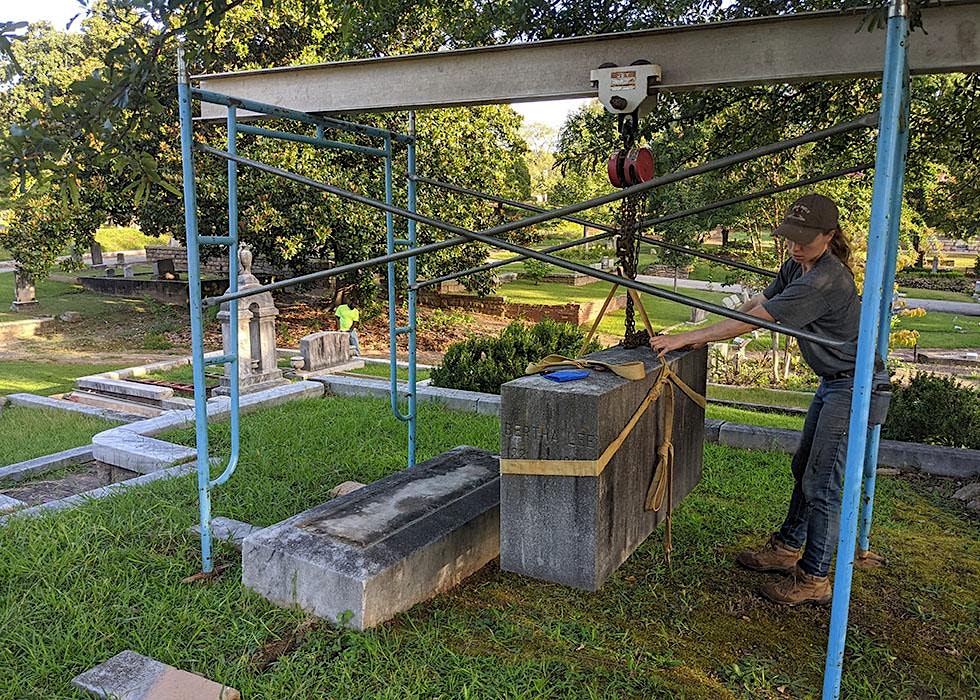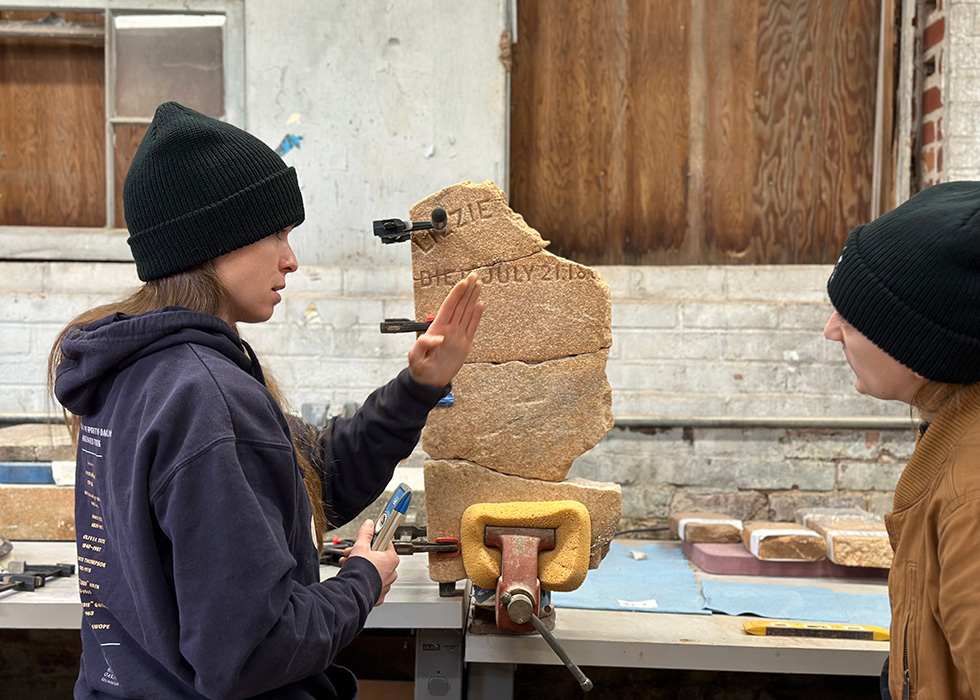
PRO Team Field Notes: Scrubbing the Surface
Since its creation in 1891, Atlanta Town Committee Chapter of the Colonial Dames has worked on and sponsored preservation projects across the country. Thanks to a generous grant from Atlanta Town Committee Chapter of the Colonial Dames, the PRO Team took on a project to assess, clean, and preserve Oakland Cemetery’s female statuary.

In 2015, Historic Oakland Foundation’s PRO Team conducted a survey to locate and inspect all 27 female sculptural monuments found in Oakland Cemetery. This fall, we identified five of those 27 statues that would make an ideal initial project to undertake. These five marble statues share common symbolism and form: each is Neoclassical in design, with the statue pointing towards the heavens, and the pleurant (mourning) figures all wear robes. However, cleaning them allows one to truly appreciate their individuality and craftsmanship. As is consistent with most of the sculptures in Oakland, these female statues are fixed upon bases of varying sizes. Three of the five monuments required ladders to ensure the entire monument was reached.
While cleaning itself does not take long, the time needed to prepare — including bring water and moving ladders — does begin to add up. Nevertheless, lessons were learned, and the PRO Team is only getting better.
To safely and thoroughly clean the female monuments the PRO Team used a combination of small and large Nylon bristle brushes, two spray bottles, a bucket of water, and D/2 cleaner. D/2 Biological Solution is an ecological cleaner safe for both the monuments and their surrounding landscape. It helps break down and remove layers of moss, lichen, dirt, and other environmental pollutants from the air and rain. A mixture of 5 parts water and 1 part D/2 was mixed in one spray bottle while the other had water.
Cleaning the monuments began with very gently dry-scrubbing the stone to remove any loose debris or vegetation. Next, we sprayed the monuments with water to open pores in the stone. After the stone is dampened, its sprayed with the D/2 cleaner. This cleaner works best over time, so we allow it to sit for a few minutes. When starting to scrub the stone, its best to keep it wet so the debris flushes away and we’re able to see what areas needed attention.
After repeatedly wetting the monument, spraying with D/2, and scrubbing again, we focused on areas that were particularly dirty. Lastly, the monument is rinsed with water. A big advantage of D/2 is that it continues to clean the stone over time; weeks after cleaning was completed, the stones still looked bright and revived. Read more about each of the monuments and how they were cleaned:

The Brown Monument
The Brown monument features a female sculpture atop a cap-and-die base. Located near the Bell Tower, the monument marks the final resting place for Mary M. Brown, who died in Atlanta in 1867 at the age of 34. The pleurant and pedestal are made of marble while the base is granite. The woman is adorned with a flower crown that denotes honor. Her right hand holds a scroll symbolizing the deeds of the deceased and she leans against an upright anchor that symbolizes hope. Cleaning this statue took a single spray bottle of D/2 and around four hours.
The Blackmon Monument
The Blackmon monument is a marble angel on a die base with a cradle grave laid out below. It marks the grave of James M. Blackmon, whose death date is 1915. The angel is depicted with outstretched wings and her hand pointing up towards heaven, while she is gazing down over the grave. Her left-hand holds an Easter lily stem and her crown also bears the five-pointed star that symbolizes heavenly wisdom. On this statue, it is easy to see a stylistic element that has been eroded away on many others: her bare foot peeks out of her robes and rests on the billows of a cloud. Such a depiction often represents piety resting on the clouds of heaven. Cleaning this statue took one bottle of D/2 and a little longer than three hours.

The Hausman Monument
The Hausman monument is a female statue on a cap-and-die base with a ledger. The monument is located on Jewish Hill and memorializes Edna Arnold Hausman who died 1906 at the age of 34. The statue is marble while the ledger, cap, and base are all granite. The sculpture is a woman with her right hand pointed to heaven while the left hand holds Easter lilies and she looks down upon the grave. She wears a crown bearing the five-pointed star of heavenly wisdom. This was the smallest statue, however, including cleaning the ledger the entire monument took around three hours to complete.

The McNamara Monument
The McNamara monument, which like the others, features a female angel with her right hand pointed to heaven while overlooking the grave. Located near Jewish Hill, the monument is dedicated to John McNamara who died in 1894. The large simple Christian cross and base are granite while the statue is marble. She holds in her left hand a scroll symbolizing the deeds of the deceased and is crowned with a five-pointed star representing heavenly wisdom. Although this statue varies the most from the others, the larger base and simple design made it possible to clean it in just under three hours, using just one bottle of D/2.



